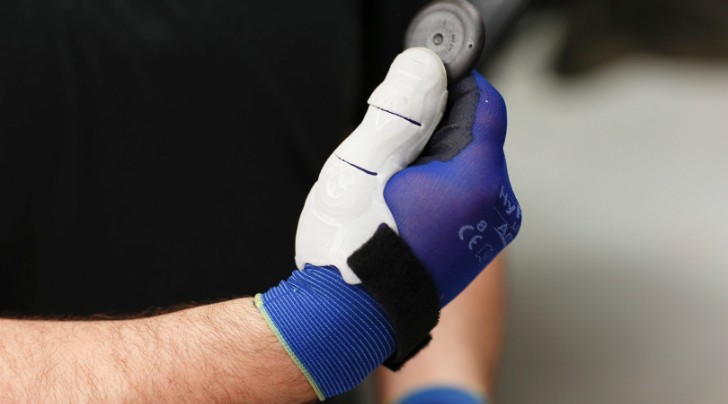After launching a pilot program involving 3D scanners that help workers find flaws in the design of various parts, BMW is now focused on helping them out even more.
Developed in collaboration with the Department of Ergonomics from the Technical University of Munich, the 3D-printed finger cot has made its first appearance in the BMW’s plants earlier this year.
Looking to offer the best possible conditions for their workers and make them feel safe and sound at the workplace, the high wigs from Munich decided to look over every aspect of their work. For example, they took a special interest in the assembly area where rubber plugs are fitted.
Over there workers have to press in with the thumb and close, among other things, the drain holes for the paint coat. Even those with very strong hand muscles have to put in a certain amount of effort in this regard, pressing on their joints numerous times a day.
In order to protect them, the company developed a flexible finger cot which protects workers against excess strains. They are made of thermoplastic polyurethane and are put over the thumb like a second skin.
At the thumb joints, the assembly aid is open to allow the thumb to move without restriction. However, if the thumb is stretched (say like in a ‘like’ gesture) the reinforced elements collide, forming a stable splint. This way, the effort needed to press in the plugs is spread across the entire thumb, down to the carpus.
Of course, the workers responded positively to this new measure and the new gear. Each of them is made specifically for its user, being 3D printed after their fingers are scanned with a 3D hand scanner.
After the hand is scanned, the future device is then computed and divided into individual layers that are then manufactured similarly to the 3D printing process, layer by layer, each of them as thin as a hair.
To go into further details, here’s how BMW puts it: “A digital data set is cut into individual layers of information. Based on the layer data, a plastic powder is selectively fused by a CO2 laser in a pre-heated construction chamber. This way, the plastic does not only mold into the layer presently created, but also merges with the previously formed one.” We’ll just leave it at 3D printing status.
Looking to offer the best possible conditions for their workers and make them feel safe and sound at the workplace, the high wigs from Munich decided to look over every aspect of their work. For example, they took a special interest in the assembly area where rubber plugs are fitted.
Over there workers have to press in with the thumb and close, among other things, the drain holes for the paint coat. Even those with very strong hand muscles have to put in a certain amount of effort in this regard, pressing on their joints numerous times a day.
In order to protect them, the company developed a flexible finger cot which protects workers against excess strains. They are made of thermoplastic polyurethane and are put over the thumb like a second skin.
At the thumb joints, the assembly aid is open to allow the thumb to move without restriction. However, if the thumb is stretched (say like in a ‘like’ gesture) the reinforced elements collide, forming a stable splint. This way, the effort needed to press in the plugs is spread across the entire thumb, down to the carpus.
Of course, the workers responded positively to this new measure and the new gear. Each of them is made specifically for its user, being 3D printed after their fingers are scanned with a 3D hand scanner.
After the hand is scanned, the future device is then computed and divided into individual layers that are then manufactured similarly to the 3D printing process, layer by layer, each of them as thin as a hair.
To go into further details, here’s how BMW puts it: “A digital data set is cut into individual layers of information. Based on the layer data, a plastic powder is selectively fused by a CO2 laser in a pre-heated construction chamber. This way, the plastic does not only mold into the layer presently created, but also merges with the previously formed one.” We’ll just leave it at 3D printing status.










